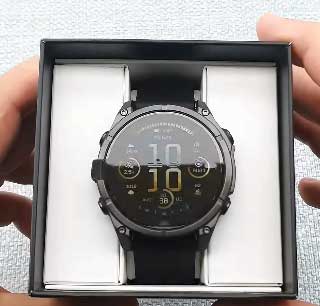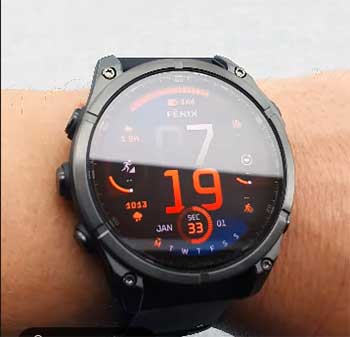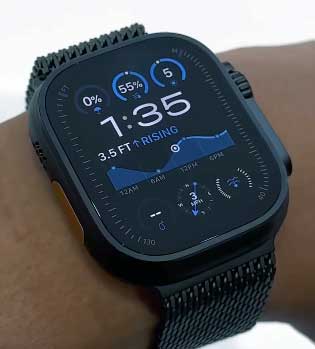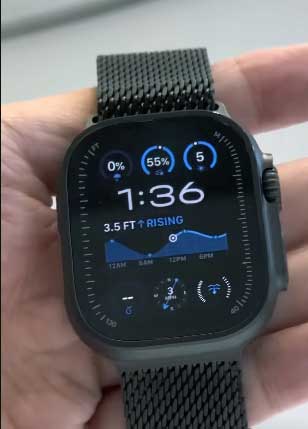When choosing a high-end smartwatch, you want to make sure it fits your lifestyle perfectly. In this article, I will share my experience and insights comparing the Garmin Fenix 8 with the Apple Watch Ultra 2. Both watches are loaded with features and cater to distinct audiences, so I’ll help you find out which one suits you better based on real user impressions and detailed pros and cons.
A Brief Comparison Table
| Feature | Garmin Fenix 8 | Apple Watch Ultra 2 |
| Display | 1.3” AMOLED | 1.92” Retina OLED |
| Battery Life | Up to 57 hours (GPS mode) | Up to 36 hours |
| Water Resistance | 10 ATM (100 meters) | WR100 (100 meters) |
| GPS Accuracy | Multi-band GNSS | Dual-frequency GPS |
| Operating System | Proprietary Garmin OS | watchOS |
| Health Tracking | Advanced with Pulse Ox, HR | Advanced heart rate, ECG |
| Smartphone Compatibility | iOS and Android | Primarily iOS |
| Mobile Payments | Garmin Pay | Apple Pay |
| Build Material | Fiber-reinforced polymer + Sapphire | Titanium + sapphire glass |
| Calling Feature | No | Yes |
| Price Range | $700 – $900 | $800 – $1000 |
My Experience With Garmin Fenix 8

Owning and using the Garmin Fenix 8, I can say it’s a powerhouse for those who prioritize ruggedness and fitness tracking.
The multi-band GPS is impressively accurate, especially when running or hiking in dense environments.
The battery life truly lasts days, which took the stress away from daily charging, a big plus for outdoor adventures.
Its robust build feels solid and durable on my wrist, and I appreciated the detailed metrics for swimming, running, cycling, and even trail running.
Installation of apps and custom watch faces can take some patience due to Garmin’s app ecosystem, but once set up, the interface is intuitive.
On the downside, the Garmin interface feels dated compared to the Apple Watch Ultra 2, and it’s not designed for quick interaction like answering calls or texting. I missed having seamless phone integration when working on the go, which is a strong suit of the Apple Watch.
The watch is more focused on performance and less on style, so it looks bulky compared to sleeker devices. If you’re an athlete or outdoor enthusiast who needs a reliable and detailed fitness tracker with long battery life, the Fenix 8 is a strong contender.
Read more: Comparison Of Autophix 3210 And Autophix 3210 Pro
Pros Of Garmin Fenix 8
- Exceptional Battery Life: Lasts weeks on basic use and can go up to 57 hours with GPS tracking.
- Highly Accurate GPS Tracking: Multi-band GNSS offers precise location data even in challenging terrain.
- Robust Build Quality: Durable with fiber-reinforced polymer, sapphire lens, and 10 ATM water resistance.
- Comprehensive Sports Tracking: Supports various activities including triathlon, trail running, and open water swimming.
- Compatibility: Works well across Android and iOS platforms.
- Advanced Health Monitoring: Includes pulse oximeter, heart rate variability, sleep tracking, and stress metrics.
- Customizable: Watch faces, apps, and sensors can be personalized extensively.
- Offline Maps Available: Download maps directly to the watch for outdoor navigation.
- Garmin Pay Available: Convenient for contactless payments without your phone.
- Solar Charging Option: Extends battery life when exposed to sunlight in specific models.
Cons Of Garmin Fenix 8

- Bulky And Less Stylish: Not the sleekest design for everyday or formal wear.
- Steep Learning Curve: Garmin’s OS and app ecosystem can require some time to master.
- Limited Smart Features: No built-in microphone or speaker for calls or voice commands.
- Sleep Tracking Is Basic: Good but less sophisticated than Apple’s algorithms.
- Slow Notifications: Interaction with smart notifications can feel clunky.
- High Price Point: Premium features come with a premium price.
- No Cellular Connectivity: Must pair with phone for most smart features.
- Updates Can Be Occasional: Firmware updates are not as frequent as Apple.
- No Music Streaming Offline: Only supports music playback from phone apps.
- Limited App Ecosystem: Fewer third-party apps compared to Apple Watch.
Maintenance Tips For Garmin Fenix 8
- Regular Firmware Updates: Keep your watch’s software current for best performance and fixes.
- Clean The Sensors: Gently wipe optical sensors on the back after workouts to maintain accuracy.
- Use The Silicone Band For Heavy Sweat: It’s easier to clean and more durable for intense physical activity.
- Avoid Harsh Chemicals: Clean the watch face with mild soap and water to avoid damaging coatings.
- Charge According To Usage: Avoid overcharging; unplug when full and use Garmin’s recommended charger.
- Protect The Display: Consider a screen protector if you engage in rough sports.
- Store Properly: Keep in a cool, dry place when not in use to preserve battery health.
- Inspect The Bands Regularly: Replace if signs of wear or cracks appear.
- Use The Watch In Native Battery Mode: To maximize battery life during lengthy outdoor sessions.
- Recalibrate GPS Occasionally: Helps maintain location accuracy over time.
My Experience With Apple Watch Ultra 2

Using the Apple Watch Ultra 2 is a different kind of experience focused on seamless integration and style. Apple’s ecosystem shines in delivering an intuitive user interface, quick responses, and smooth interactions. Making calls or replying to messages directly on the watch works flawlessly, which kept me connected on the go.
The larger display is vibrant and responds fluidly to touch, ideal for everyday tasks or workout stats. I found the health tracking equally impressive, with ECG, heart rate monitoring, and even temperature sensing adding layers of detail. The watch also felt very comfortable and stylish on my wrist, making it suitable for both workouts and office wear.
Battery life is decent but not as long-lasting as the Garmin’s, requiring daily charging, which can be inconvenient if you want to track sleep habitually. The GPS is excellent but doesn’t quite match Garmin’s precision in extreme outdoor conditions. Apple’s app ecosystem is vast, giving you access to countless apps for fitness, productivity, and entertainment.
If you prioritize connectivity, style, and seamless smartphone features, the Apple Watch Ultra 2 might be your best bet.
Pros Of Apple Watch Ultra 2
- Seamless Ecosystem Integration: Works effortlessly with iPhone and other Apple devices.
- Excellent Display: Large Retina screen with vibrant colors and high resolution.
- Comprehensive Health Features: ECG, blood oxygen, temperature, heart rate, and fall detection.
- Built-in Microphone and Speaker: Allows calls, Siri use, and quick voice replies.
- Advanced GPS Tracking: Dual-frequency GPS delivers reliable outdoor navigation.
- Great App Selection: Huge library of third-party apps enhances functionality.
- Comfortable And Stylish: Titanium body with a sleek look suitable for all occasions.
- Water Resistant To 100 Meters: Safe for swimming and water sports.
- Fast Charging: Quick to recharge compared to previous models.
- Emergency Features: Includes crash detection and emergency SOS.
Cons Of Apple Watch Ultra 2
- Shorter Battery Life: Needs charging daily with moderate use.
- iPhone Only: Limited compatibility with non-Apple devices.
- Higher Price: Premium features come at a steep cost.
- Screen Vulnerability: Larger screen is more prone to scratches and damage.
- No Multi-Band GPS: Slightly less accurate in dense forests or urban canyons.
- Less Focused On Extreme Sports: Lacks some specialized outdoor metrics Garmin offers.
- No Solar Charging: Battery depends fully on wired charging.
- Limited Offline Maps: Relies heavily on iPhone for most map functions.
- Watch Bands Are Expensive: Proprietary bands cost significantly more.
- Requires Apple Account: Must be integrated with Apple account services for full use.
Maintenance Tips For Apple Watch Ultra 2

- Keep Software Updated: Apple regularly releases updates for security and features.
- Clean Regularly: Use a soft, lint-free cloth to clean the screen and body.
- Avoid Extreme Temperatures: Keep the watch in temperature ranges specified by Apple.
- Use Screen Protectors: Protect the large screen from scratches and cracks.
- Remove Bands Occasionally: Clean bands separately according to material (silicone, leather, or metal).
- Charge Using Apple Charger: Always use certified chargers to avoid damage.
- Store Properly When Not In Use: Avoid moisture or dust buildup for longevity.
- Turn Off When Not Used For Long: To preserve battery life when Idle.
- Monitor Battery Health: Replace battery if it depletes really fast over time.
- Be Cautious With Water Exposure: Although water-resistant, avoid soap or detergents exposure.
Comparison With Other Brands
- Apple Watch Ultra 2 Vs Samsung Galaxy Watch 6: The Apple Watch Ultra 2 outperforms the Galaxy Watch 6 in terms of fitness tracking precision and ecosystem integration with iPhones. Samsung’s watch is compatible with both Android and iOS but offers a less seamless experience on iOS. Battery life tends to be similar, but Apple’s Ultra has a more robust build and stronger health features like ECG and temperature sensing.
- Garmin Fenix 8 Vs Suunto 9 Peak: Both Garmin and Suunto focus on premium outdoor sports watches. Garmin Fenix 8 boasts longer battery life and more extensive multi-band GPS accuracy, while Suunto 9 Peak offers a lighter, sleeker design with solid navigation tools. Suunto’s app ecosystem is less extensive, but its interface is easier for casual users compared to Garmin’s complex setup.
- Apple Watch Ultra 2 Vs Fitbit Sense 2: Fitbit Sense 2 is more budget-friendly and offers basic health tracking features, but it lacks the depth and smart functionalities of the Apple Watch Ultra 2. Apple’s device provides superior app support, premium materials, and more advanced sensors like ECG and fall detection. Fitbit, however, excels in sleep tracking and stress management for users focused on wellness rather than performance.
- Garmin Fenix 8 Vs Polar Grit X Pro: Both watches cater to serious athletes and adventurers. Garmin has an edge with multi-band GNSS and a wider variety of sport profiles. Polar Grit X Pro is lighter and offers excellent heart rate accuracy but doesn’t match Garmin’s battery endurance or map features. Polar’s interface is user-friendly, making it a great alternative for users seeking performance with simplicity.
- Apple Watch Ultra 2 Vs Google Pixel Watch: Apple Watch Ultra 2 leads with better build quality, longer software support, and advanced health sensors. Google Pixel Watch integrates well with Android services but falls short in battery life and fitness feature depth compared to Apple’s device. Apple users will find the Ultra 2 more cohesive within their ecosystem, while Pixel Watch caters to Android enthusiasts who want smartwatch basics with Google Assistant.
- Garmin Fenix 8 Vs Coros Vertix 2: Both are rugged outdoor watches designed for endurance athletes. Garmin offers a more polished ecosystem and extensive third-party app support, whereas Coros Vertix 2 impresses with longer battery life and a more affordable price tag. Coros’s interface is simpler but less customizable than Garmin’s. The choice depends on whether the user prioritizes ecosystem or battery endurance.
Read more: My Thoughts on Chubby Cable Screen Protector
Frequently Asked Questions (FAQ)
It depends on your needs. Garmin Fenix 8 excels in battery life and rugged outdoor use, while Apple Watch Ultra 2 shines in connectivity and smart features.
For sports and adventure, Garmin is generally better. For daily smart use and iPhone integration, Apple wins.
Yes, the Garmin Fenix series meets military-grade standards for durability and water resistance (MIL-STD-810).
No, the Fenix 8 does not support making phone calls directly.
Conclusion: For Garmin Fenix 8
If your priority is durability, long battery life, and superior outdoor and fitness tracking, the Garmin Fenix 8 is a capable and dependable choice that can withstand harsh conditions and offer precision metrics for serious athletes.
Conclusion: For Apple Watch Ultra 2
If you value a sleek design, easy-to-use smart features, and tight integration with your iPhone, the Apple Watch Ultra 2 will keep you connected in style, with impressive health monitoring and daily usability.
Choosing between these two depends on whether you lean more into outdoor performance or smart connectivity for everyday life.
